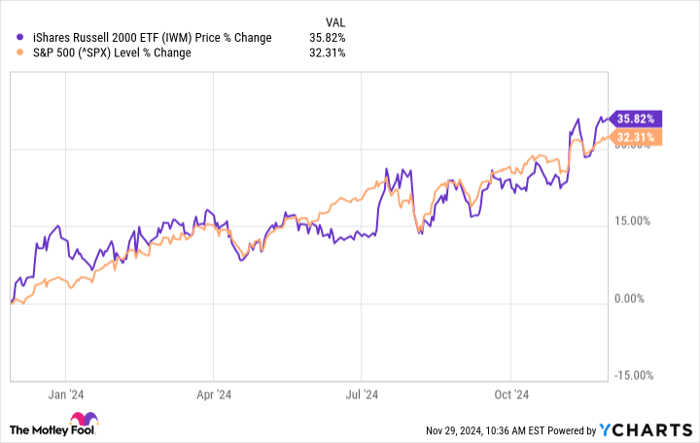The stock market has surged over the last two years, driven by the artificial intelligence (AI) boom, falling inflation, and a resilient economy in the face of high interest rates.
However, while the S&P 500 (SNPINDEX: ^GSPC) surged, one corner of the stock market was left behind. Small-cap stocks have badly underperformed since their peak during the pandemic, as they fell sharply in the bear market of 2022, as the highfliers that had jumped during the pandemic fell the furthest.
Through 2023 and 2024, small caps have also been left behind as investor attention has been focused on large-cap tech stocks like Nvidia and others that have soared on optimism for the AI revolution. However, small caps finally seem to be making up for lost ground, as the best-known small-cap index, the Russell 2000, just reached a new all-time high for the first time since 2021.
Small caps have surged since the election, as investors have bet that President-elect Donald Trump and a Republican Congress can enact a set of potentially business-friendly policies like lower taxes, less regulation, and higher tariffs. While small caps would be very unlikely to benefit from tariffs, investors seem to think they are less likely to be impacted by them, in general, as multinational companies tend to be large caps.
Through Nov. 26, the Russell 2000 is up 7.2% since the election, though the majority of those gains came the day after Election Day, a sign that investors believe that the incoming Trump administration would have a favorable impact on them.

Image source: Getty Images.
Are small caps back?
Historically, small-cap stocks have outperformed large-cap stocks in bull markets, but underperformed them in bear markets.
That's because small-cap stocks tend to be riskier and more volatile than their large-cap peers. Small-cap stocks also tend to be younger companies. They're also more likely to be unprofitable, have weak balance sheets, and have more difficulty surviving a recession.
They are more prone to struggle in weak economic environments, but that volatility cuts both ways. When investors are feeling confident about the market, small caps tend to outperform, in part because they have more upside potential than their large-cap peers. It's much easier for a smaller company to double its revenue than it is for a large company, for example, and that explains when investors are eager to put their money into small-cap stocks when they're confident in the economy.
There's another reason why small-cap stocks are starting to get some momentum. They're also significantly cheaper than their large-cap peers, and that discount price could help set off a rotation from large-cap stocks into small-caps as long as economic confidence remains.
One small-cap ETF to buy now
If you're looking to take advantage of the expected rotation into small-cap stocks, one way to do it is with the iShares Russell 2000 ETF (NYSEMKT: IWM). The iShares Russell 2000 ETF is the largest small-cap ETF that follows the Russell 2000. Currently, it trades at a price-to-earnings ratio of 15.3, which looks like a deep discount compared to the iShares Core S&P 500 ETF, which currently has a 30.3% P/E ratio.
Data by YCharts.
With small-cap ETFs trading at half the price of their large-cap peers, investing in the sector makes sense, especially with the broader optimism around the Trump administration and the general resilience of the U.S. economy.
The iShares Russell 2000 ETF makes investing in small-cap stocks easy by allocating your investment into roughly 2,000 stocks and for the modest expense ratio of 0.19%.
With the valuation gap between small caps and large caps likely to narrow, and sentiment finally starting to favor small caps, investing in a small-cap ETF like iShares Russell 20000 ETF looks like a smart move.
Should you invest $1,000 in iShares Trust - iShares Russell 2000 ETF right now?
Before you buy stock in iShares Trust - iShares Russell 2000 ETF, consider this:
The Motley Fool Stock Advisor analyst team just identified what they believe are the 10 best stocks for investors to buy now… and iShares Trust - iShares Russell 2000 ETF wasn’t one of them. The 10 stocks that made the cut could produce monster returns in the coming years.
Consider when Nvidia made this list on April 15, 2005... if you invested $1,000 at the time of our recommendation, you’d have $847,211!*
Stock Advisor provides investors with an easy-to-follow blueprint for success, including guidance on building a portfolio, regular updates from analysts, and two new stock picks each month. The Stock Advisor service has more than quadrupled the return of S&P 500 since 2002*.
*Stock Advisor returns as of November 25, 2024
Jeremy Bowman has no position in any of the stocks mentioned. The Motley Fool has positions in and recommends Nvidia. The Motley Fool has a disclosure policy.
The views and opinions expressed herein are the views and opinions of the author and do not necessarily reflect those of Nasdaq, Inc.



